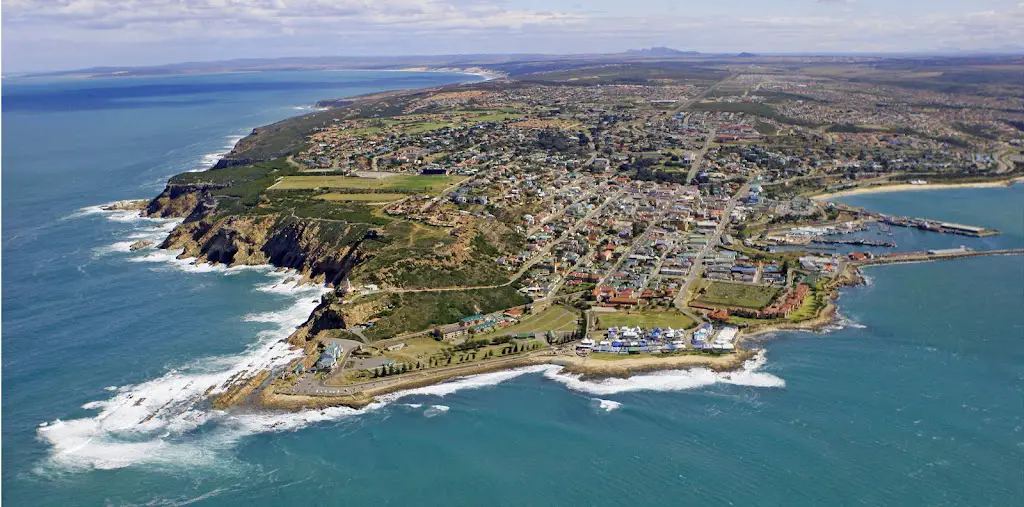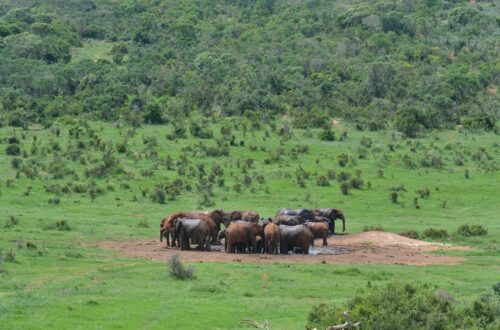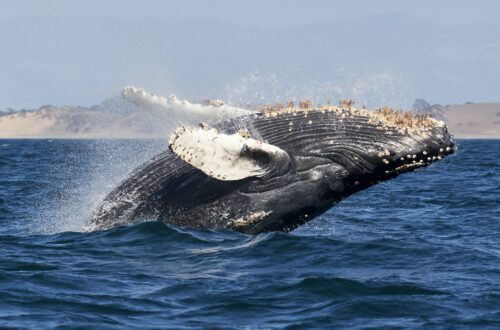Namibia: A Paradise Untouched – The Jewel of Africa
Namibia is a destination like no other! From its breathtaking landscapes to its rich cultural heritage, this African gem offers a one-of-a-kind experience that should be on everyone’s bucket list. In this blog post, we will try to delve into the captivating aspects of Namibia, the jewel of Africa including what to see, what to do, what to eat, when to go, and where to stay.
The Namib desert.
The Namib Desert, one of the world’s oldest and most magnificent deserts, stretches along the Atlantic coast of Namibia. It invites nature enthusiasts and avid photographers to experience the desert’s unforgettable beauty. Every step unveils a photographic paradise. Located in southwestern Africa, it is a natural wonder with a rich history and unique features.
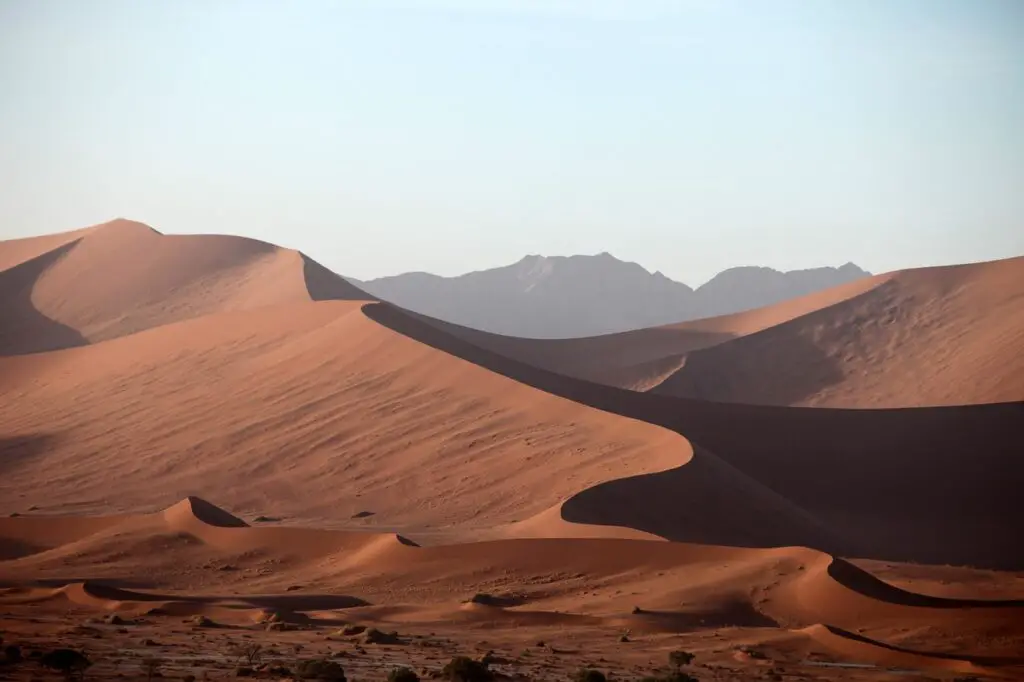
It is recognized as one of the oldest deserts in the world, having endured arid or semi-arid conditions for approximately 55-80 million years. Its age and geological history make it a remarkable natural, with an intriguing past that spans millions of years.
It boasts a one-of-a-kind ecosystem and supports a surprising variety of desert-adapted flora and fauna. From elusive gemsbok, springbok, and oryx to specialized desert plants. This desert hosts a spectrum of life that has evolved to thrive in extreme conditions.
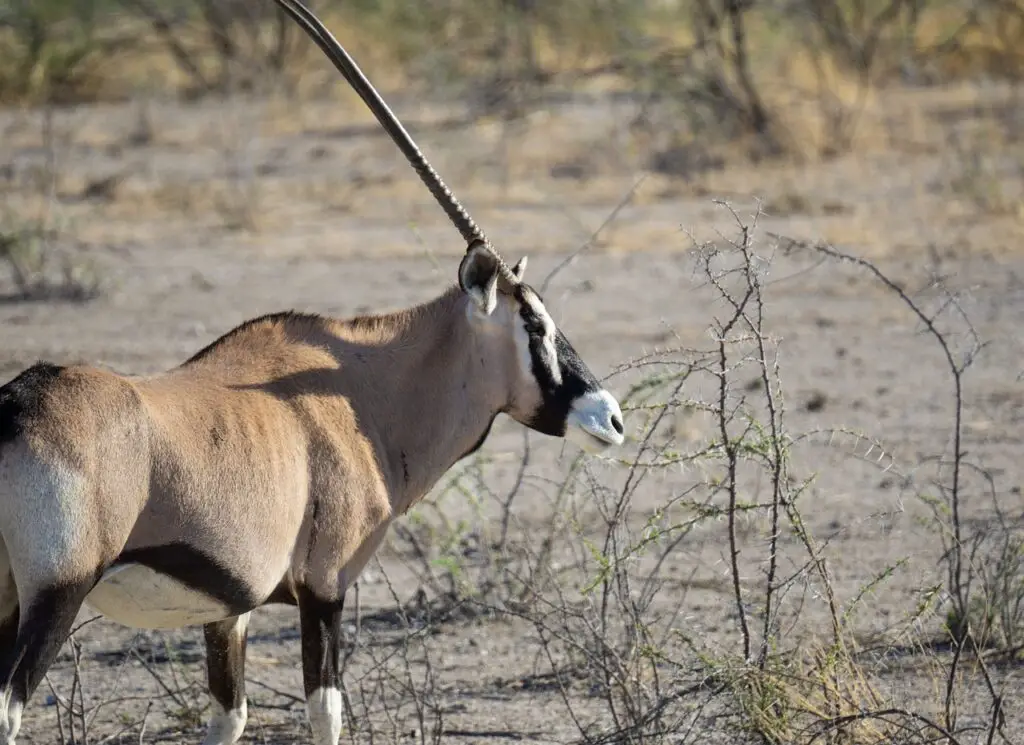
The desert’s inhabitants have developed remarkable adaptations and survival techniques to cope with the harsh desert environment. These adaptations include water-saving mechanisms, heat tolerance, and specialized behaviors. That allows them to endure the extreme conditions of the Namib Desert.
A Symphony of Red Sand Dunes.
A prominent destination within the Namib Desert is Sossuvlei, known for its captivating red sand dunes. The towering red sand dunes are a sight to behold. These massive dunes, including the famous Dune 45. They create a dramatic and awe-inspiring landscape, making it a must-visit for nature enthusiasts and photographers.
The interplay of light and shadow on the red dunes creates a surreal ambiance that changes throughout the day. Sunrise and sunset are particularly magical times to experience this natural wonder. The colors and shapes of the dunes transform with the shifting light.
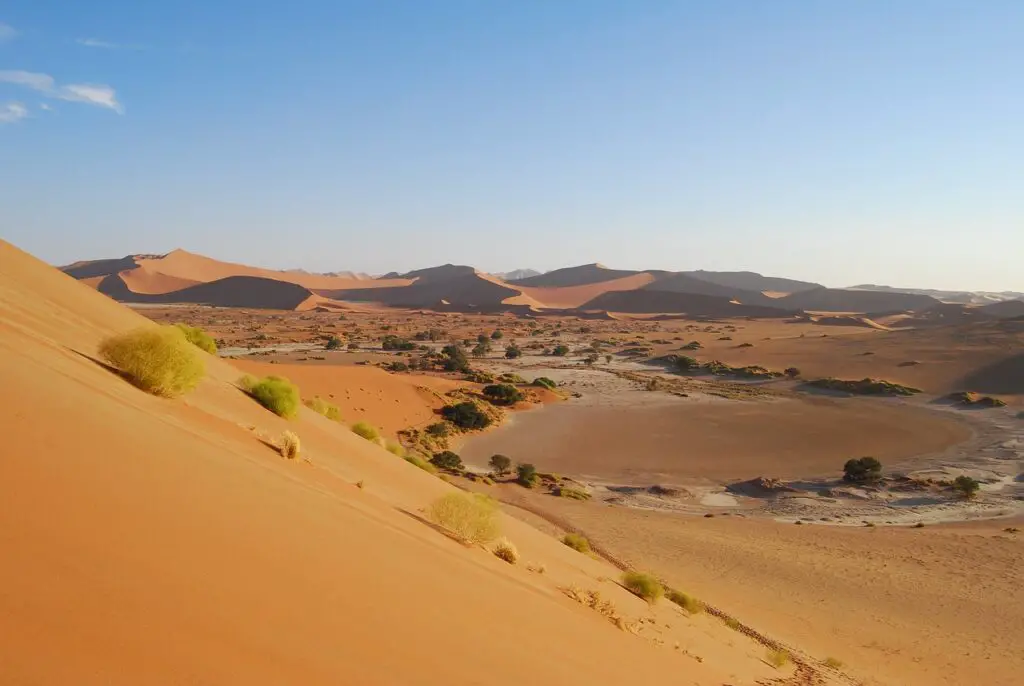
The dunes of Sossusvlei are not static but constantly shifting due to the desert winds. This ongoing transformation shapes the landscape and adds to the desert’s dynamic nature.
Visitors are drawn to the challenge of climbing the towering dunes to enjoy breathtaking panoramic views of the surrounding desert. The effort is rewarded with stunning vistas that stretch as far as the eye can see.
Nature’s Surreal Art Gallery.
A unique clay pan within the Namib Desert known for its otherworldly beauty:
Deadvlei is characterized by its stark, white clay pan surrounded by the towering red dunes of Sossusvlei. This striking contrast of colors makes it a hauntingly beautiful location.
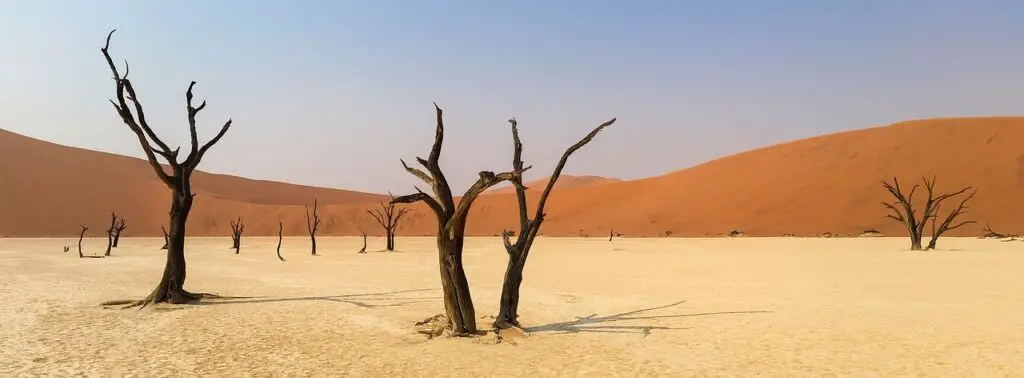
The clay pan is dotted with ancient, petrified camel thorn trees. Their blackened skeletons stand in stark contrast to the white pan and red dunes. These trees add an eerie and surreal quality to the landscape.
Deadvlei is a magnet for photographers. Due to the ever-changing interplay of light and shadow.Making it a prime location for capturing stunning and evocative images.
Photographers often seek the best vantage points to capture the perfect shot at Deadvlei. Composing photographs to accentuate the contrast and unique elements of the landscape is an art in itself.
Wildlife Encounters in the Namib Desert.
Exploring the Namib Desert offers opportunities to encounter unique desert-adapted wildlife:
Visitors have the chance to observe a range of desert-adapted species, including gemsbok, springbok, oryx, and other animals that have evolved to survive in the harsh desert conditions.
Gemsbok, springbok, and oryx are some of the iconic desert wildlife species that can be encountered. Their adaptations to the desert environment are fascinating to observe.
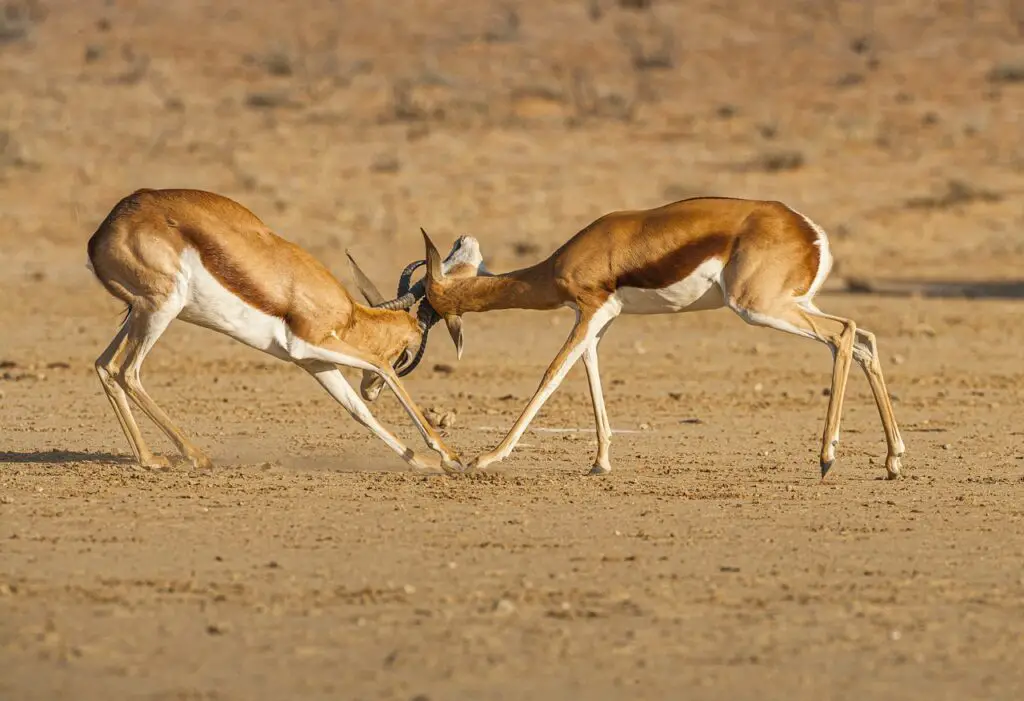
Birdwatchers will find a variety of avian species in the Namib Desert, including adapted desert birds. Observing these birds and their behaviors in the arid landscape is a unique experience.
Exploring the desert and its wildlife provides insights into the incredible adaptations and survival strategies that enable these animals to thrive in one of the world’s harshest environments.
Adventure Activities in Sossusvlei.
Sossusvlei offers a range of adventurous experiences for visitors:
Thrill-seekers can enjoy quad biking and dune surfing on the sandy slopes of the dunes. These activities provide an adrenaline rush amid the breathtaking scenery.
For a more tranquil adventure, hot air balloon rides offer a bird’s-eye perspective of the vast desert landscape, providing a unique and serene way to appreciate the dunes and their surroundings.
Guided hikes and nature walks provide opportunities to explore hidden gems in the desert, such as lesser-known dunes and unique geological features.
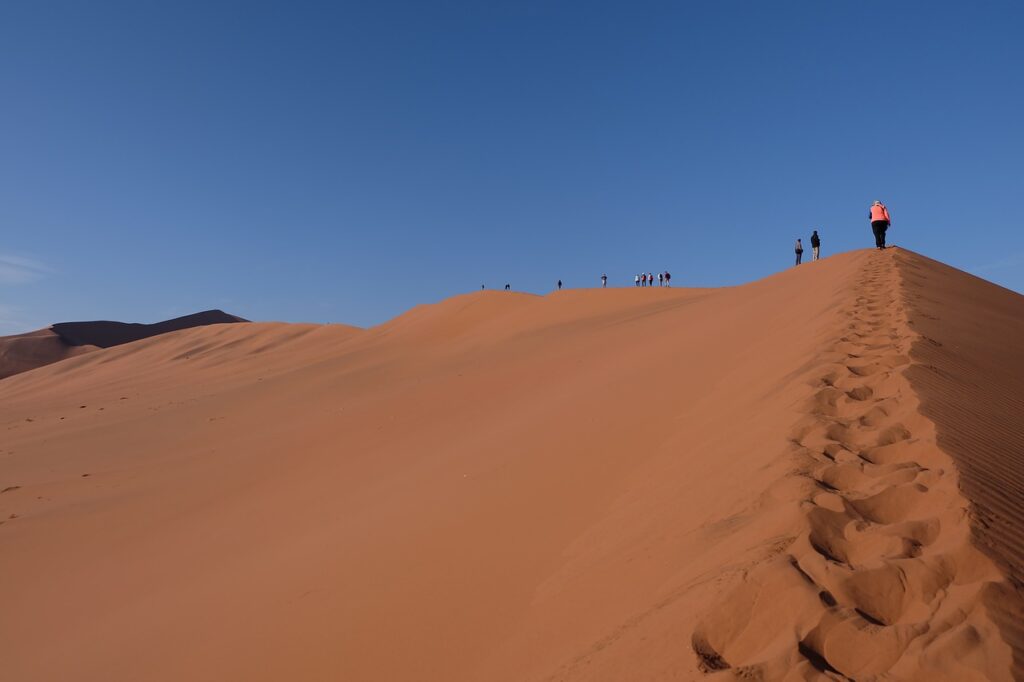
The Namib Desert’s remote location ensures minimal light pollution, making it an ideal destination for stargazing. Visitors can enjoy the clear night sky and celestial wonders.
In Conclusion: Namib Desert and Sossusvlei offer an otherworldly experience for nature enthusiasts and photographers alike. With its vast expanse of red sand dunes, the iconic Deadvlei, and a unique ecosystem, this region never fails to leave visitors captivated. Whether you choose to witness the breathtaking sunrises and sunsets, capture the surreal landscapes through your lens, or embark on thrilling adventures, the Namib Desert and Sossusvlei promise an unforgettable journey to nature’s masterpiece.
Extraordinary Wildlife Adventure at Etosha National Park.
Etosha National Park is a wildlife enthusiast’s paradise located in the heart of Namibia. With its diverse landscape and abundance of wildlife, this destination promises an unforgettable safari experience. Get ready to witness the majestic lions, elephants, rhinos, and a myriad of other species in their natural habitat. In this blog post, we’ll take you on a virtual journey through Etosha National Park, highlighting its key attractions, thrilling wildlife encounters, and insightful tips for a memorable adventure.
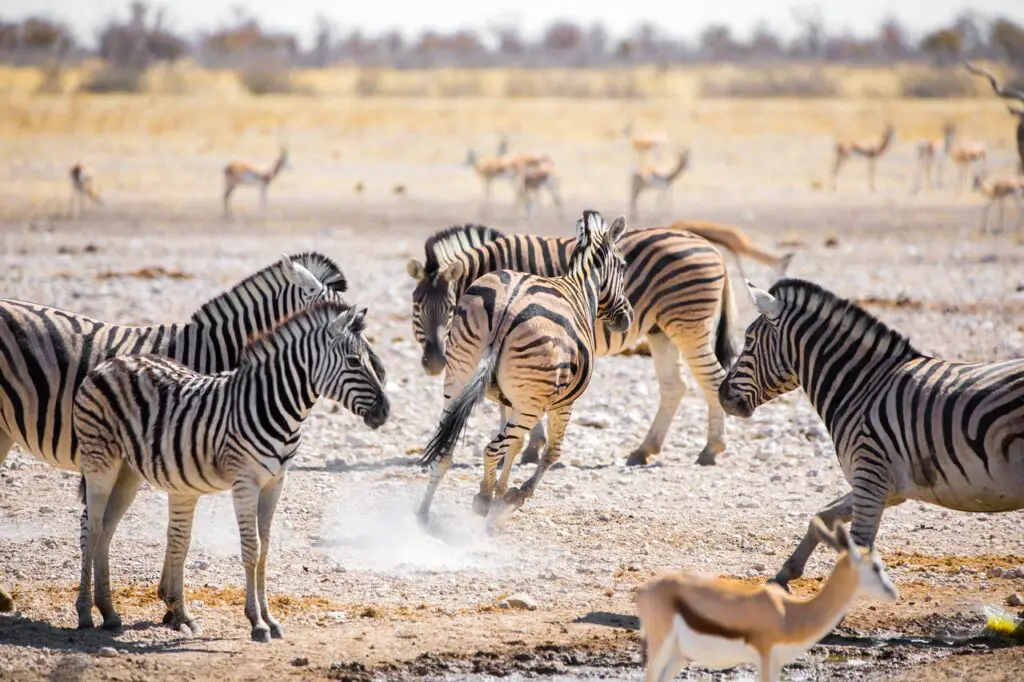
Untamed Beauty of Etosha National Park:
Etosha National Park is renowned for its vast salt pan, stretching over 4,800 square kilometers, which dominates the landscape. As you explore the park, you’ll encounter mesmerizing savannahs, lush grasslands, and Mopane woodlands. The juxtaposition of these diverse ecosystems creates a stunning backdrop for your wildlife safari.
Encounter the Kings of the Jungle: Lions.
Etosha National Park boasts a healthy population of lions, giving visitors the chance to witness these magnificent creatures in their natural habitat. Prepare to be awe-struck as you observe them prowling, hunting, and lounging in the wild. Remember to capture these extraordinary moments with your camera, but always prioritize the safety guidelines provided by the park authorities.
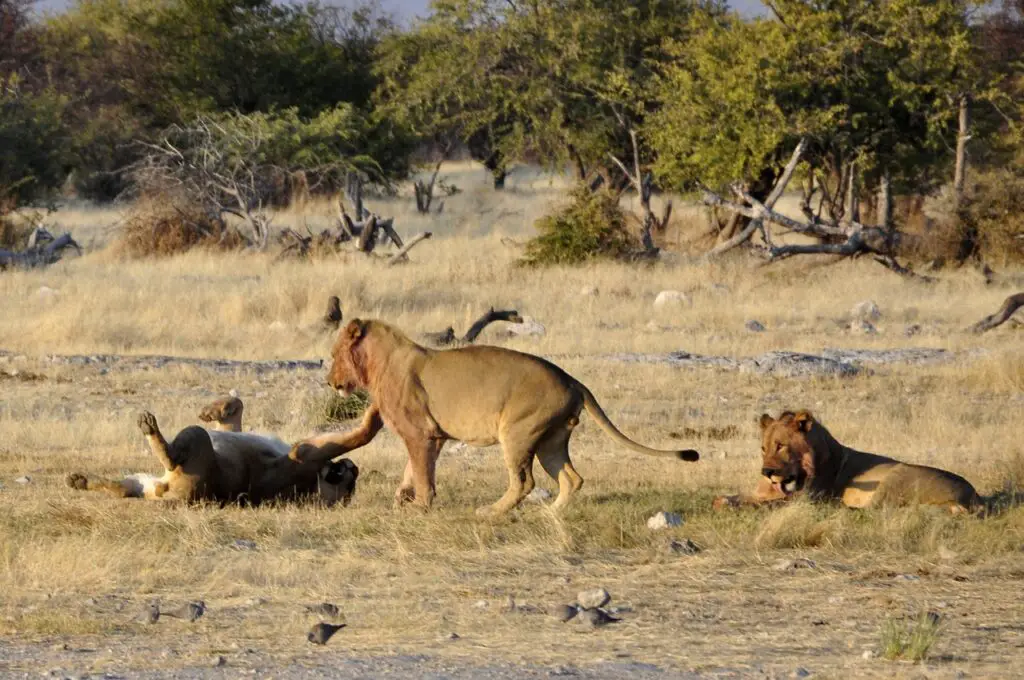
Marvel at the Grace of Elephants:
The park is home to a significant number of elephants, offering you a unique opportunity to witness these gentle giants up close. Experience the magic of their majestic presence as you see them grazing, bathing, and interacting within their social groups. Keep your eyes peeled for adorable elephant calves, as they bring an extra dose of cuteness to your safari adventure.
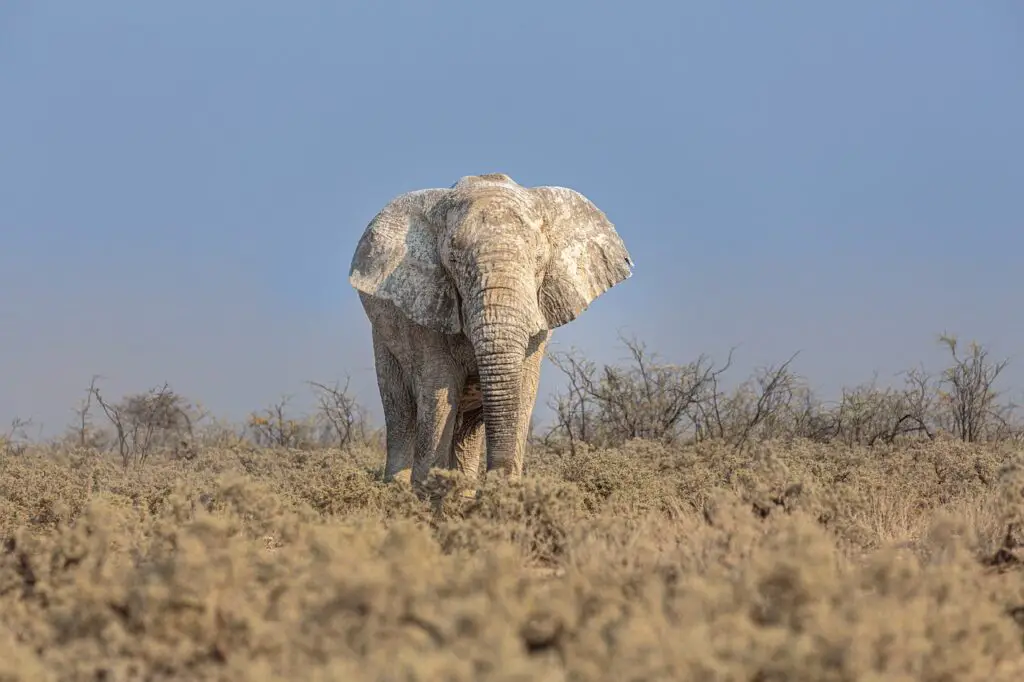
Protecting the Rhinos: Conservation Efforts in Etosha National Park:
Rhinos, particularly the endangered black rhinos, find sanctuary within the protected boundaries of Etosha National Park. Witness these magnificent creatures and learn about the conservation efforts being made to protect them from poaching. Support the park’s initiatives by spreading awareness and respecting ethical wildlife tourism practices.
Etosha National Park is a treasure trove of diverse wildlife species beyond lions, elephants, and rhinos. As you explore the park, keep an eye out for graceful cheetahs, elusive leopards, striking giraffes, and numerous antelope species. This biodiversity makes every moment of your safari a thrilling and captivating experience.
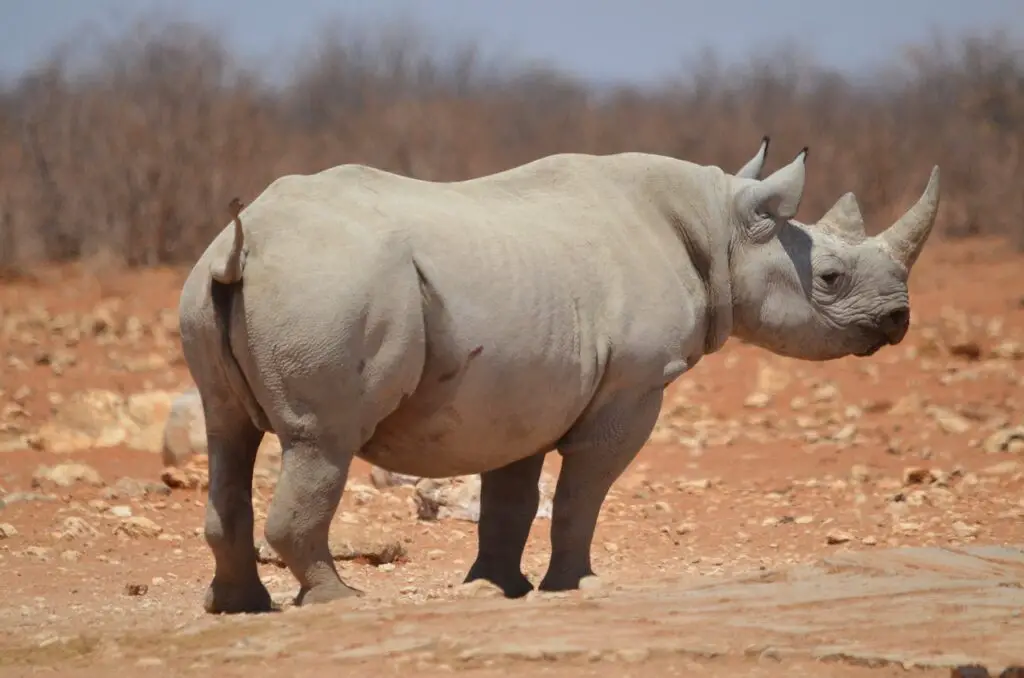
Etosha National Park offers an unparalleled wildlife experience, showcasing the untamed beauty of nature and providing unforgettable encounters with majestic African creatures. Whether you’re an avid wildlife photographer, a nature enthusiast, or simply seeking an exhilarating adventure, a safari in Etosha National Park will leave you with memories to cherish for a lifetime. Plan your visit and embark on an extraordinary journey to witness the wonders of nature at this remarkable destination.
the Coastal Charms of Namibia.
Nestled along Namibia’s captivating coastline lies one of Africa’s hidden gems – Swakopmund. With its blend of German-inspired architecture, breathtaking landscapes, and a plethora of adrenaline-pumping activities, this charming coastal town is a prime destination for adventure seekers. Let’s delve into the heart of Swakopmund and discover the exhilarating experiences it has to offer.
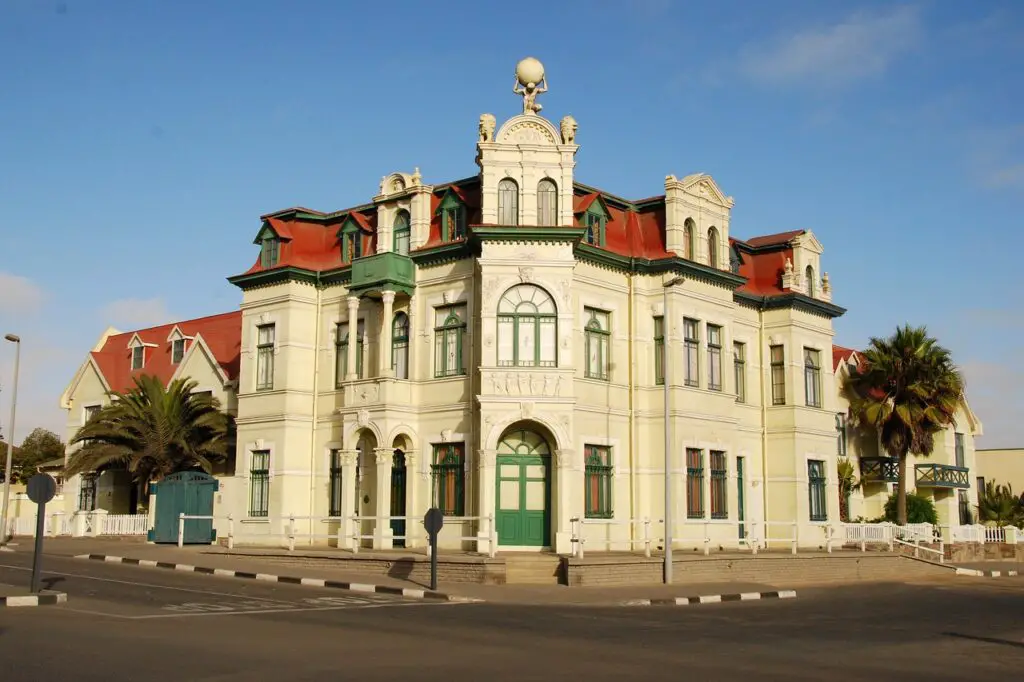
Swakopmund, a town infused with the remnants of German colonial architecture, exudes a unique cultural charm that transports visitors back in time. Strolling through its quaint streets, visitors are greeted with an array of cafes, restaurants, and shops that offer a taste of both local and international cuisine.
The rush of adrenaline
For thrill-seekers, Swakopmund is a paradise that promises an adrenaline rush like no other. Embark on a journey of a lifetime as you engage in an array of heart-pounding activities amidst spectacular natural surroundings.
Once in Swakopmund, sandboarding is an absolute must-try experience. Brace yourself as you glide down towering sand dunes, feeling the rush of adrenaline with every twist and turn. Whether you’re a novice or an experienced boarder, the vast desert landscape provides the perfect playground for an unforgettable adventure.
If you’re looking to take your adventure to new heights, then skydiving in Swakopmund is the answer. Imagine free-falling through the sky, soaking in breathtaking aerial views of the coastal town and its surrounding beauty. This once-in-a-lifetime experience is sure to leave you awe-inspired and craving for more.
For those seeking an off-road escapade, quad biking is the ultimate choice. Hop on an all-terrain vehicle and navigate through the mesmerizing desert landscapes, conquering challenging terrains with a mix of excitement and thrill. Feel the adrenaline surge through your veins as you zip through the dunes, immersing yourself in the raw beauty of Swakopmund’s natural wonders.
Culture and Natural History.
Beyond the adrenaline-fueled activities, Swakopmund has much more to offer. Explore the town’s intriguing museums, like the Swakopmund Museum, which offers a glimpse into Namibia’s rich cultural and natural history. Take a stroll along the picturesque beachfront promenade or witness the stunning sunset over the Atlantic Ocean.
Swakopmund also invites visitors to delve into its rich cultural heritage. Explore the local markets and craft shops, where you can find unique handcrafted souvenirs and interact with the warm-hearted locals. The town’s German influence is evident in its cuisine, showcasing a fusion of Namibian and European flavors that will tantalize your taste buds.
Swakopmund presents an incredible opportunity to immerse yourself in coastal charm while indulging in heart-racing adventures. From sandboarding down towering dunes to skydiving amidst breathtaking vistas, this Namibian gem is a magnet for adrenaline enthusiasts. So, pack your bags, embark on this unforgettable journey, and let Swakopmund redefine your adventure-filled vacation.
Africa’s Breathtaking Natural masterpiece
Welcome to the awe-inspiring world of Fish River Canyon! Situated in Namibia, this natural wonder stands as Africa’s largest canyon and offers an unforgettable experience for adventurers and nature enthusiasts alike. Brace yourself for breathtaking hikes and awe-inspiring views that will leave you in complete awe. In this blog post, we will delve into the grandeur of Fish River Canyon, exploring its highlights and the mesmerizing experiences it has to offer.
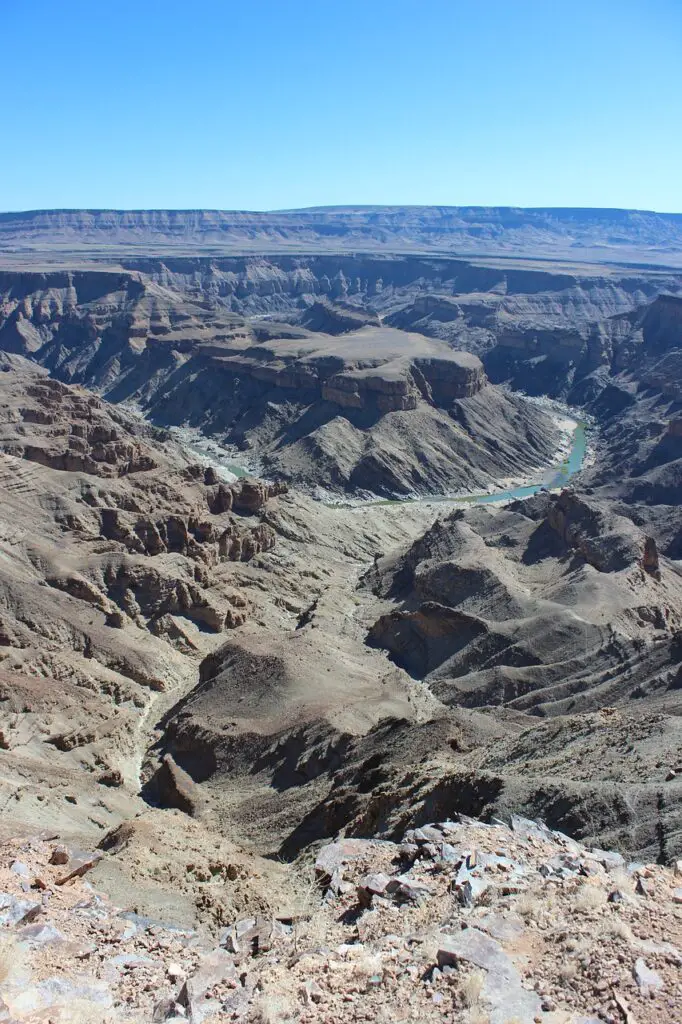
A Glimpse of Fish River Canyon’s Magnificence
Step into a world of wonders as you set foot in Fish River Canyon. This geological marvel stretches over 100 miles in length, reaching depths of around 1,800 feet. It offers visitors an extraordinary sight filled with striking rock formations and awe-inspiring vistas that will leave you speechless. Nature enthusiasts and photographers flock here to capture the grandeur of this unparalleled landscape.
The Fish River Hiking Trail: A Test of Endurance:
For the adventurous souls seeking a challenge, the Fish River Hiking Trail is an experience like no other. This 55-mile-long trail takes you on a multi-day expedition through the heart of the canyon. Be prepared to navigate rocky terrain, cross rivers, and camp under the vast African sky. The journey is physically demanding, but the rewards are immeasurable. Every step unveils breathtaking panoramic views, serene pools, and hidden waterfalls.
Wildlife Encounters in Fish River Canyon:
Fish River Canyon is not just a magnificent geological wonder, but it’s also home to an array of wildlife. Keep your eyes peeled for sightings of baboons, zebras, kudus, and numerous bird species as you explore the trails. For nature lovers, there are few things more magical than observing these animals in their natural habitat against the backdrop of the canyon’s majestic cliffs.
The Canyon’s Rich History and Cultural Significance:
Beyond its natural splendor, Fish River Canyon holds a rich history and cultural significance. Indigenous communities have inhabited these lands for centuries, leaving behind a wealth of lore and traditions. Engage with local guides to learn about the stories and legends associated with the canyon, gaining a deeper understanding of the region’s cultural heritage.
Spectacular Sunrise and Sunset Moments:
Prepare to be dazzled by the magic of sunrise and sunset in Fish River Canyon. As the sun casts its golden hues over the rugged landscape, the beauty is simply unparalleled. Find a vantage point along the canyon’s rim, and let the colors of the sky blend with the grandeur of the canyon, painting a picture that will forever remain etched in your memory.
Fish River Canyon stands as a testament to the Earth’s majestic wonders. From its breathtaking hikes and awe-inspiring views to its vibrant wildlife and cultural significance, this natural gem offers an experience unlike any other. Brace yourself as you embark on an adventure through the grandeur of Africa’s largest canyon, and let Fish River Canyon leave an indelible mark on your soul.
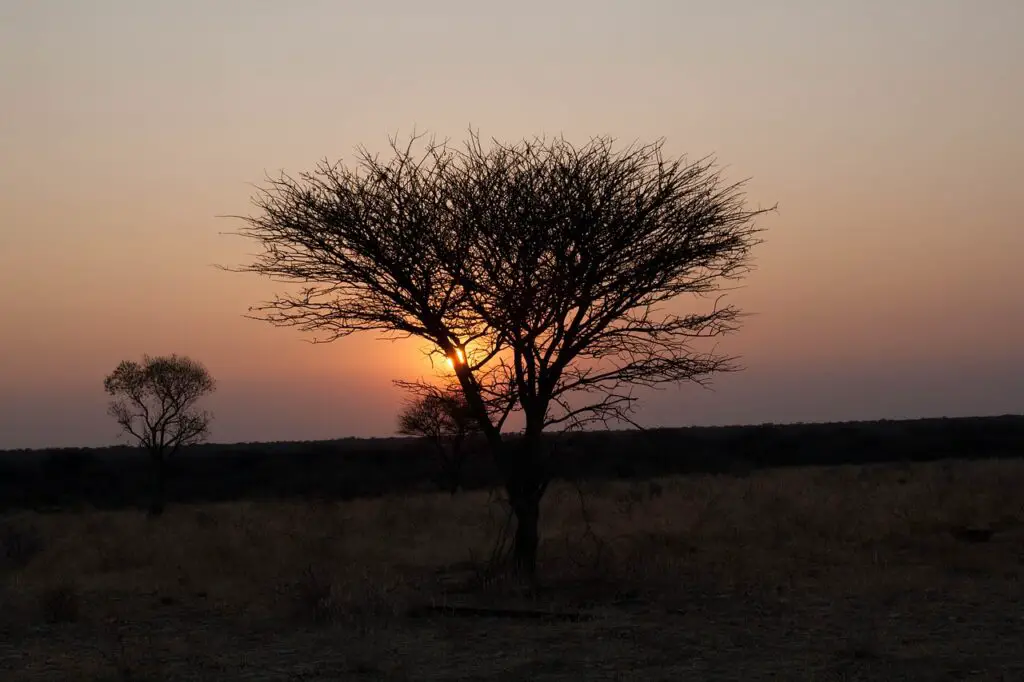
Certainly, Namibia offers incredible opportunities for wildlife enthusiasts, not just in the Namib Desert but throughout the country.
Here are some of the best places to visit in Namibia:
Namib-Naukluft National Park:
While famous for its stunning desert landscapes, this park is also home to oryx, springbok, and desert-adapted wildlife.
Damaraland:
This region offers a chance to spot desert elephants, rare black rhinos, and a variety of desert-adapted species.
Caprivi Strip:
Located in the far northeast, this region is rich in birdlife and is home to aquatic species along the Zambezi River.
Waterberg Plateau Park:
A haven for wildlife conservation, this park is home to reintroduced species like cheetahs and black and white rhinos.
Chobe River:
While predominantly in Botswana, the Chobe River area is easily accessible from Namibia and offers incredible river-based wildlife viewing.
Skeleton Coast:
Explore the unique landscapes and spot wildlife like seals and desert-adapted lions along this remote coastline.
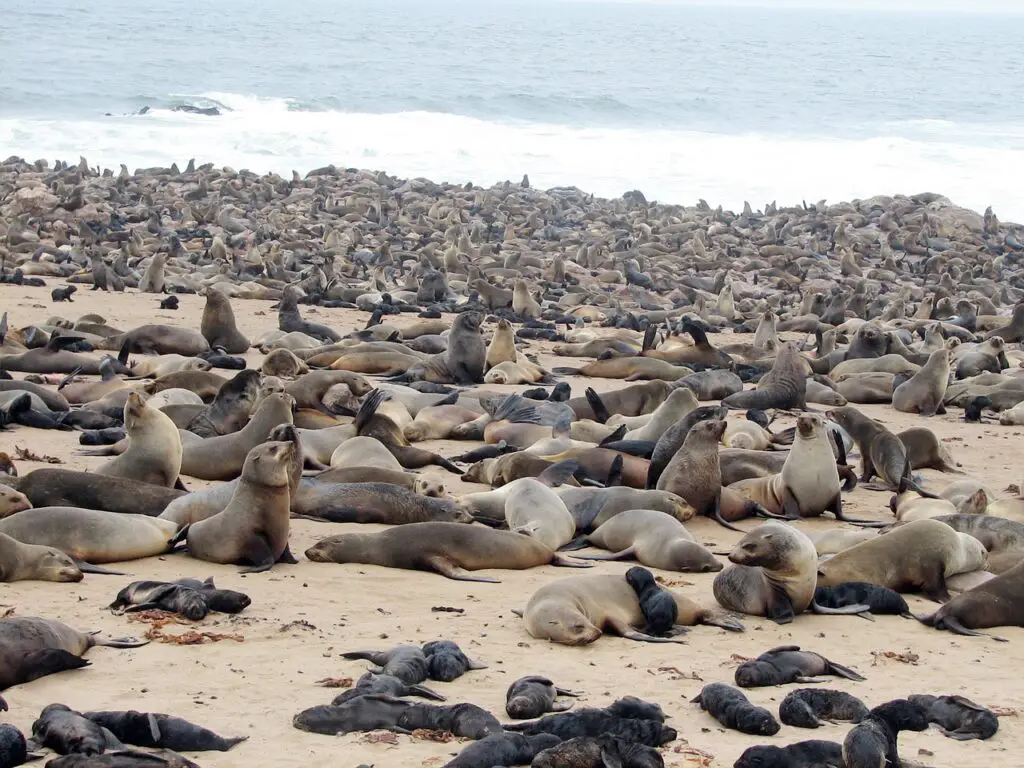
Cape Cross:
Home to a large population of Cape fur seals. known for their incredible size, with tens of thousands of seals often present.
Kaokoland:
Home to the Himba people and known for its remote wilderness, this region offers a unique cultural and natural experience.
Epupa Falls:

Located in the far north, these are one of Namibia’s most picturesque waterfalls and offer a tranquil escape.
Luderitz:
A charming coastal town known for its German colonial architecture, visit the ghost town of Kolmanskop nearby.
Kolmanskop:
Explore this eerie ghost town overtaken by the desert, a remnant of Namibia’s diamond-mining past.

Spitzkoppe:
Known as the “Matterhorn of Namibia,” this dramatic granite peak is a favorite for rock climbers and hikers.
Twyfelfontein:
Home to ancient rock engravings, it’s a UNESCO World Heritage Site and a glimpse into the past.
Mahango Game Reserve:
In the Caprivi Strip, this reserve provides excellent opportunities for birdwatching and wildlife encounters.
Tsumeb:
Visit the Tsumeb Museum and explore this town’s rich mining history.
Quivertree Forest and Giant’s Playground (Keetmanshoop):
This site features both the iconic quiver trees and intriguing rock formations, making it similar to the Kalahari Giants Playground. You can admire the stunning quiver trees and enjoy the unique geological features.
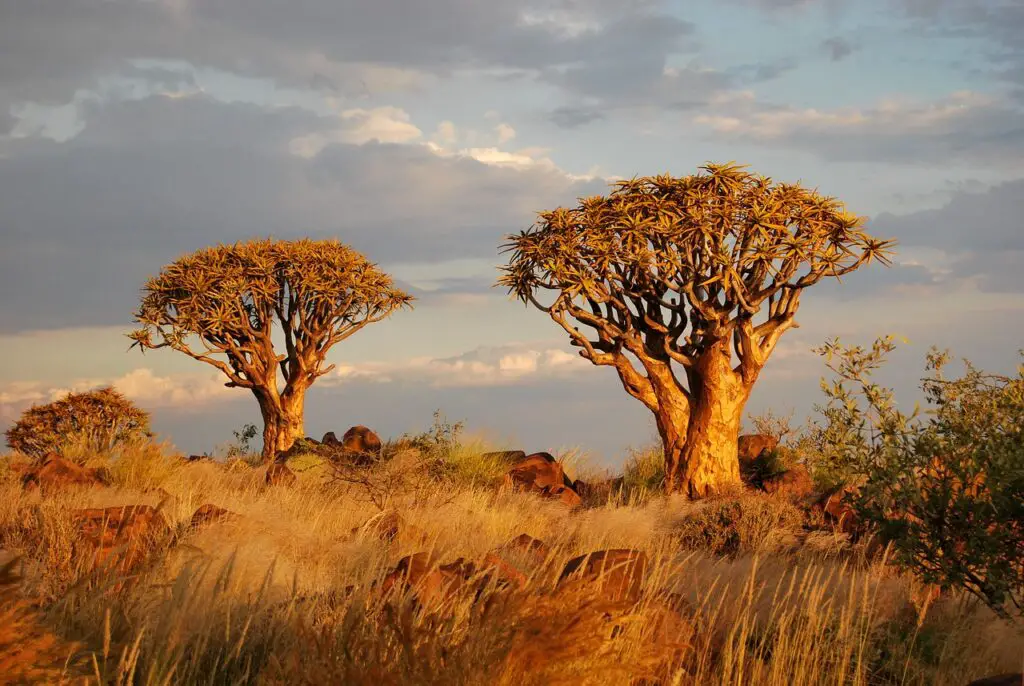
The Kalahari Desert;
Is known for its breathtaking landscapes, wildlife, and unique desert flora.If you’re interested in wildlife safaris, nature exploration, or simply enjoying the desert’s tranquility,
These locations provide opportunities to see diverse wildlife and experience Namibia’s natural beauty. Many tour operators offer wildlife safaris and guided experiences to make the most of your wildlife adventure in Namibia.
Cultural Sojourn with the Himba People
The Himba people are a semi-nomadic group with a fascinating history and a unique way of life. They primarily inhabit the remote and arid region of Kaokoland in Namibia. With a history dating back centuries, the Himba have thrived in this challenging environment, relying on their deep connection with nature. Their nomadic lifestyle is characterized by moving their herds of livestock in search of grazing lands and water sources. Living in harmony with the environment, the Himba have developed a profound understanding of the land and its resources.
Himba are renowned for their distinctive appearance. They wear traditional clothing that suits their harsh environment. The women, in particular, are known for their striking ochre-dyed hair, which holds significant cultural and aesthetic value.

Their culture is rich in ceremonies and rituals that play a vital role in their daily lives. The holy fire ceremony, for instance, is a spiritual event that reinforces the connection between the Himba and their ancestors. Visitors have the opportunity to witness these ceremonies and gain a deeper understanding of their cultural significance.
Immersion in the Himba Community:
For an authentic experience, visitors can opt for homestays within Himba communities. This provides a firsthand opportunity to live with a Himba family, participate in their daily activities, and gain insights into their way of life.
Engaging in activities such as jewelry making, pottery, and milking offers a chance to learn age-old techniques passed down through generations. This hands-on experience is a way to appreciate the craftsmanship and artistry of the Himba people.
One of the most enriching aspects of visiting the Himba is the exchange of stories, experiences, and traditions. By sharing and listening, visitors and the Himba create a bridge of cross-cultural understanding that fosters respect and appreciation.
Conservation and Community Initiatives:
Responsible tourism can empower the Himba people while preserving their cultural heritage and the natural environment. Contributing to sustainable tourism initiatives ensures that the Himba continue to thrive while protecting their way of life.
Visitors can get involved in local initiatives aimed at improving education, healthcare, and infrastructure within the Himba community. This not only benefits the Himba but also strengthens the bonds between them and the visitors
Embarking on a cultural journey with the Himba people offers an unparalleled experience of discovering a society rooted in ancient traditions. From their stunning attire to their ochre-dyed hair, every aspect of their culture tells a story. Engaging with the Himba people not only broadens our perspectives but also plays a pivotal role in ensuring the preservation of this captivating way of life. So, pack your curiosity and embark on a transformative adventure that will leave you with lasting memories and a deeper understanding of the world we live in.
Flavorful World of Namibian Cuisine
Namibia, a land of diverse landscapes and cultures, offers a culinary journey that is as captivating as its scenery. The country’s cuisine is a melting pot of traditions, influenced by its indigenous communities and colonial history. In this article, we will embark on a gastronomic adventure to discover the delectable delights of Namibian cuisine.
Kapana – The Irresistible Street Food:
Namibia’s bustling streets come alive with the aroma of kapana. This popular street food is a must-try for anyone looking to savor the local flavors. It consists of skewered and grilled meat, often beef, marinated with a medley of spices and served with fresh accompaniments like tomatoes, onions, and sauces. The experience of indulging in kapana is not only a treat for your taste buds but also an immersion into the vibrant street culture of Namibia.
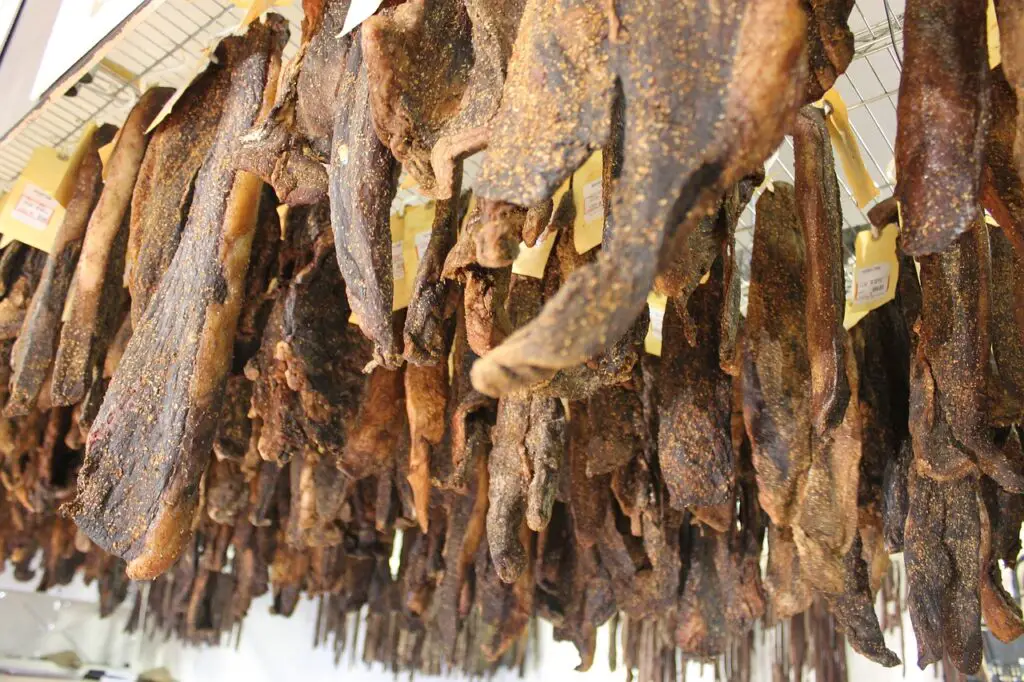
Biltong – The Quintessential Snack:
Biltong, a beloved Namibian snack, is the local answer to jerky. It is prepared by air-drying and curing meat, typically beef, game, or even fish, with a blend of seasonings. The result is a savory, high-protein snack that’s perfect for on-the-go adventures. Biltong is available in various flavors, making it an addictive treat for locals and visitors alike.
Potjiekos – A Hearty Stew:
For a heartwarming taste of Namibia, potjiekos is the answer. This slow-cooked stew is traditionally prepared in a three-legged cast-iron pot, imparting a unique flavor. Potjiekos is a delightful medley of meats, vegetables, and spices, often cooked over an open flame. The combination of ingredients and the slow cooking process result in a rich, flavorful dish that warms the soul
Apfelstrudel – German Inspiration:
Namibia’s culinary landscape also reflects its colonial heritage. German influences are evident in the beloved dessert, Apfelstrudel. This pastry is made with thin layers of dough filled with spiced apples, raisins, and cinnamon. Served warm and often accompanied by a dollop of cream, Apfelstrudel is a delightful treat for those with a sweet tooth.
Namibian cuisine is a delightful fusion of flavors, with traditional dishes like kapana and potjiekos coexisting harmoniously with international influences like Apfelstrudel. Exploring Namibia’s culinary landscape is a journey for your taste buds and an opportunity to connect with the rich history and culture of this extraordinary country. So, as you explore Namibia’s stunning landscapes, don’t forget to explore its delectable cuisine. Your culinary adventure awaits!
the Perfect Time to Explore Namibia
Namibia, a land of diverse landscapes and abundant wildlife, is a captivating destination for travelers. But when is the best time to visit this stunning country? The answer depends on your preferences and the experiences you seek. Let’s explore the different seasons and their advantages to help you plan your Namibian adventure.
Dry Season (April to October):
The dry season is widely regarded as the best time to visit Namibia. It stretches from April to October, offering cooler temperatures and clear skies. This period is ideal for wildlife enthusiasts as animals tend to gather around water sources, making for excellent game-viewing opportunities. Be sure to explore renowned national parks like Etosha during this season for unforgettable encounters with Namibia’s incredible wildlife.
The Cooler Months:
May to September are considered the coolest months in Namibia. Milder temperatures are a relief from the scorching heat of the summer, making outdoor activities more comfortable. It’s also the perfect time for hiking and exploring the breathtaking landscapes, from the iconic dunes of the Namib Desert to the dramatic Fish River Canyon.
Mild Nights and Starry Skies:
Namibia’s dry season offers more than just pleasant daytime weather. The clear, crisp nights are a stargazer’s paradise. With minimal light pollution, you can witness some of the most incredible celestial displays. Don’t forget to include stargazing in your Namibian itinerary.
Green Season (November to March):
While the dry season is popular, the green season has its unique charm. From November to March, Namibia experiences its rainy season. The landscapes transform as the dry earth gets covered in lush greenery and colorful wildflowers. Birdwatchers will be delighted as migratory birds flock to the region.
The Summer Experience:
The green season does come with higher temperatures and the possibility of occasional rain showers. However, if you don’t mind a bit of heat and a refreshing downpour, you’ll find that this season offers a unique perspective of Namibia’s natural beauty.
Namibia is a year-round destination, but the dry season from April to October is the prime time for wildlife enthusiasts and those who prefer cooler temperatures. If you’re eager to witness the lush green landscapes and don’t mind a bit of warmth, the green season from November to March has its own allure. No matter when you visit, Namibia’s diverse landscapes and incredible wildlife promise an unforgettable adventure. So, choose the season that suits your preferences and embark on a journey to this mesmerizing African nation.
Where to Stay in Namibia: Options for Every Budget
Namibia, known for its breathtaking landscapes and diverse wildlife, offers a wide array of accommodation options to suit all budgets. Whether you’re a luxury traveler seeking an immersive experience in the heart of wildlife reserves or a budget-conscious adventurer looking for cozy guesthouses or self-catering apartments, Namibia has something to offer everyone. Here’s a guide to the types of accommodations you can find in this beautiful country:
Some links
- https://www.namibia-accommodation.com/
- https://www.info-namibia.com/accommodation
- https://www.roughguides.com/namibia/accommodation/
Luxury Lodges and Tented Camps:
Namibia is home to exquisite luxury lodges and tented camps. These accommodations provide the perfect blend of comfort and nature. Imagine waking up to stunning views of wildlife right outside your door. Many of these lodges offer guided safaris, fine dining, and spa services, ensuring a memorable and indulgent stay.
Wildlife Reserves and National Parks:
For nature enthusiasts, staying within wildlife reserves and national parks is a dream come true. These options range from self-catering campsites to more comfortable lodges. Staying inside these protected areas provides unmatched access to wildlife and pristine landscapes.
Cozy Guesthouses:
Namibia boasts charming guesthouses that offer a homely atmosphere. These are excellent for travelers who prefer a more intimate and local experience. Expect warm hospitality, local insights, and well-appointed rooms.
Self-Catering Apartments:
If you prefer more independent and budget-friendly options, self-catering apartments are readily available. These come equipped with kitchens, allowing you to prepare your meals. It’s an excellent choice for longer stays and those who appreciate the flexibility of self-catering.
Budget-Friendly Hotels:
Budget-conscious travelers can find affordable hotels in Namibia. While these may not offer the frills of luxury lodges, they provide comfortable and clean accommodations, making them an excellent choice for those looking to explore the country on a budget.
Camping and Campsites:
For adventurous souls, camping is a fantastic way to connect with Namibia’s wild side. Numerous campsites are spread throughout the country, allowing you to immerse yourself in the great outdoors.
Namibia offers diverse accommodation options, ensuring that every traveler, regardless of their budget, can experience this remarkable country. Whether you prefer luxury lodges, cozy guesthouses, self-catering apartments, or camping under the starlit Namibian sky, you’re bound to find the perfect place to stay while exploring the beauty of Namibia.
Transportation Tips for Your Adventure
Traveling around Namibia is a unique adventure given its vast and diverse landscapes. To make the most of your journey, consider these transportation tips:
- Self-Driving: Renting a car or 4×4 vehicle is a popular choice. Namibia’s well-maintained roads allow for exploration at your own pace. Just ensure you have a valid driver’s license and drive cautiously, especially on gravel roads.
- Domestic Flights: With several domestic airports, flying is a convenient way to cover long distances quickly. Air Namibia offers domestic flights for seamless travel.
- Buses: Long-distance buses connect major cities and towns. The Intercape Mainliner is a reputable company for intercity travel, providing an affordable and efficient means of getting around.
- Minibuses and Shared Taxis: In urban areas, minibusses and shared taxis (combis) offer cost-effective transportation options for navigating cities.
- Guided Tours: Joining guided tours or safaris is a fantastic way to explore the country, especially if you prefer not to self-drive. Numerous tour operators offer guided experiences, providing in-depth knowledge of Namibia’s attractions.
- Trains: While not as common, Namibia does offer train services such as the Desert Express and Shongololo Express, providing a unique travel experience.
- Hitchhiking: Namibia is relatively safe for hitchhiking, allowing you to meet locals and fellow travelers. However, exercise caution and prioritize your safety at all times.
Namibia’s expansive size means planning your routes and transportation in advance is crucial. Each mode of travel has its advantages, so choose the one that aligns with your preferences and itinerary. Whether you opt for a self-drive adventure or a guided tour, Namibia’s remarkable scenery is sure to leave a lasting impression on your journey.
In Conclusion.
Namibia is a destination that truly captivates the soul and ignites the spirit of adventure. Whether you’re in search of surreal landscapes, encounters with diverse wildlife, immersive cultural experiences, or a serene escape into untouched natural beauty, Namibia has it all. The country’s enchanting deserts, vast savannahs, rugged mountains, and unique ecosystems provide a backdrop for unforgettable journeys.
From the towering red dunes of Sossusvlei to the wildlife-rich plains of Etosha National Park, from the otherworldly beauty of the Fish River Canyon to the cultural richness of Namibia’s indigenous communities, this country offers a myriad of experiences for travelers with diverse interests.
Namibia’s well-preserved environment and warm hospitality make it a place where memories are created and cherished. So, whether you’re planning a self-drive adventure, a guided safari, or an exploration of the local culture, Namibia beckons you to embark on a journey that will stay etched in your heart forever.
Pack your bags, plan your itinerary, and set out to explore this untouched paradise. Namibia is not just a destination; it’s an invitation to a world of wonder and adventure that you’ll treasure for a lifetime.


